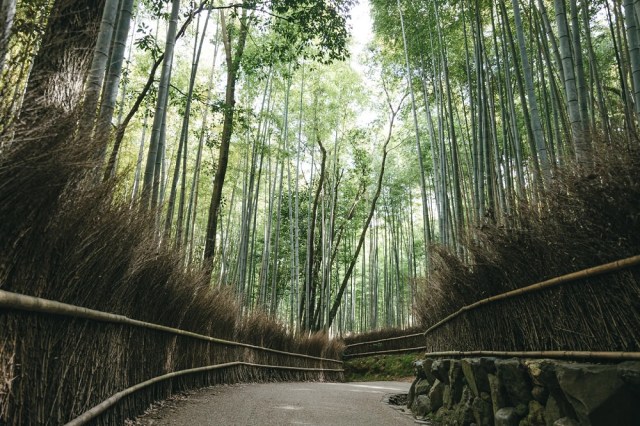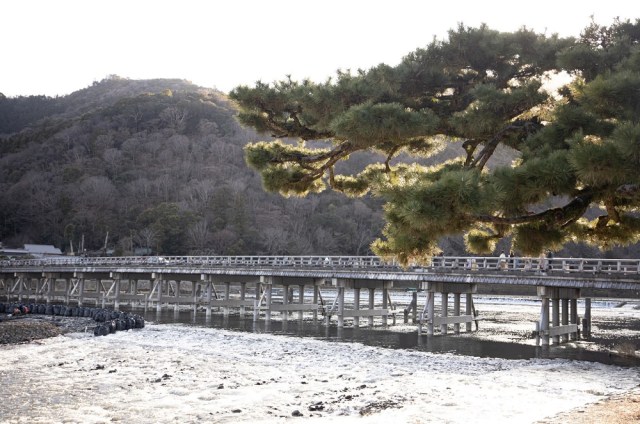
But an increase alone isn’t likely to completely solve the problem.
From its picturesque riverside area and iconic bamboo forest to art galleries and garden restaurants, there’s a lot to see in Kyoto’s Arashiyama neighborhood. One thing you won’t see very much of there, though, is public trash cans.
That’s not an entirely unique situation. Travelers to Japan often remark on how few and far between trash cans are, even in heavily touristed areas. However, the Arashiyama Hoshokai, a local promotion and preservation organization whose members include local merchants, says it wants more trash cans installed to help combat a rise in littering.
Trash cans used to be more plentiful in Arashiyama, but that didn’t always translate into clean streets. In the video below, some of the neighborhood’s previous city-installed streetside garbage receptacles can be seen. The cans are overflowing, with domes of trash sticking up above the rim formed by people continuing to pile up garbage even after the cans are at capacity. Because the piles aren’t very steady, they’d eventually topple or get blown over by the wind, causing trash to spill onto the sidewalk and into the street.
Because of this, says Kazuma Tadano from the Kyoto municipal government’s Town Beautification Promotion Division, Arashiyama locals requested that many trash cans be removed from the area, with the intended hoped-for effect of communicating to tourists that they were expected to take any trash they might generate back to their hotel or home.
However, with Arashiyama on its way back to the 8 million visitors it received annually prior to the pandemic, the issue of how to handle trash is once again demanding attention. Even if most visitors are conscientious about hanging on to their trash until they can find a place to properly dispose of it, with so many visitors coming to the neighborhood, even a small percentage of them littering/precariously piling trash means a lot of garbage on the ground. It’s getting to be an especially big problem now that the summer travel season is here. At the point in the video cued below, the same bank of trash cans in Arashiyama’s bamboo groove is shown at 9 a.m. on the left, and at 3 p.m. the same day on the right, with the containers completely full and trash on the ground in front of them in the afternoon.
With scenes like this becoming increasingly common, Junji Makino, head of Arashiyama Hoshokai, says “In the end, we really do need public trash cans,” and “To start with, we’d like [the city government] to reinstall trash cans in the places where we previously had them.”
Makino acknowledges that the presence of trash cans can lead to more trash on the streets, as people try to stack or cram items on/in to a can that’s already full. He makes special mention of half-eaten snacks from streetside vendors, and in the video you can see visitors eating ice cream, pickles, and other refreshing treats. Still, the current small number of trash cans simply isn’t enough, and increasing their number will help lessen the amount of trash on the street, Makino and Arashiyama Hoshokai feel.
“Lessen” is an important distinction to make here, though, as even with more trash cans, it’s probably not going to be unusual to find many that are already full. Part of what makes Arashiyama so appealing to visitors is that it’s one of the less developed parts of Kyoto, but preserving that charming old-school atmosphere likely means that the city would be reluctant to have large fleets of noisy garbage trucks driving around the neighborhood’s narrow streets to make multiple trash pickups every day, to say nothing of the additional budget burden. So keping Arashiyama clean is probably going to take extra efforts on both sides: more trash cans from the city government, and tourists also being prepared and committed to take what trash they can back with them.
If you want to help do your part as a visitor, there are two simple things you can do. Should you happen to buy food or a drink from a street vendor, if you enjoy it nearby (as opposed to walking far away while eating/drinking it), you can usually ask the vendor to throw the plate/bowl/skewer/cup/etc. way for you with the phrase “Kore wo sutete moraemasu ka?” (“Can you throw this away for me?”). The other thing to do is in the morning, before leaving your hotel and coming to Arashiyama, make sure you’ve got a plastic bag or two inside your backpack/shoulder bag/purse. That way if you do have trash but can’t find a sufficiently empty trash can, you can stick it in the bad and take it back with you, and help leave Arashiyama looking as beautiful when you leave as it did when you arrived.
Source: YouTube/FNNプライムオンライン
Top image: Pakutaso
Insert images: Pakutaso
● Want to hear about SoraNews24’s latest articles as soon as they’re published? Follow us on Facebook and Twitter!


 Arashiyama bamboo forest in Kyoto “crying” as tourists vandalise trees
Arashiyama bamboo forest in Kyoto “crying” as tourists vandalise trees Titan trash can to be placed near a Coca-Cola vending machine in Oita to help promote recycling
Titan trash can to be placed near a Coca-Cola vending machine in Oita to help promote recycling Sumida River Fireworks Festival aftermath: Not everyone in Japan has perfect manners after all
Sumida River Fireworks Festival aftermath: Not everyone in Japan has perfect manners after all Jack-‘o-lantern trash bags being handed out to fight litter during Tokyo Halloween parties
Jack-‘o-lantern trash bags being handed out to fight litter during Tokyo Halloween parties Kyoto village dealing with poo on floor as Japanese-style toilets confuse foreign travelers
Kyoto village dealing with poo on floor as Japanese-style toilets confuse foreign travelers Should you add tartar sauce to Japanese curry rice? CoCo Ichi makes diners an unusual offer
Should you add tartar sauce to Japanese curry rice? CoCo Ichi makes diners an unusual offer Foreigner’s request for help in Tokyo makes us sad for the state of society
Foreigner’s request for help in Tokyo makes us sad for the state of society Seaside scenery, history, and so many desserts on Yokohama’s Akai Kutsu【Japan Loop Buses】
Seaside scenery, history, and so many desserts on Yokohama’s Akai Kutsu【Japan Loop Buses】 Japanese city loses residents’ personal data, which was on paper being transported on a windy day
Japanese city loses residents’ personal data, which was on paper being transported on a windy day Ghibli Park now selling “Grilled Frogs” from food cart in Valley of Witches
Ghibli Park now selling “Grilled Frogs” from food cart in Valley of Witches Red light district sushi restaurant in Tokyo shows us just how wrong we were about it
Red light district sushi restaurant in Tokyo shows us just how wrong we were about it Harajuku Station’s beautiful old wooden building is set to return, with a new complex around it
Harajuku Station’s beautiful old wooden building is set to return, with a new complex around it Japanese ramen restaurants under pressure from new yen banknotes
Japanese ramen restaurants under pressure from new yen banknotes Katsudon vs. tonkatsu vs. katsu sandwich – What’s the best way to eat pork cutlet in Japan?
Katsudon vs. tonkatsu vs. katsu sandwich – What’s the best way to eat pork cutlet in Japan? New limited-edition Starbucks Japan drinks are for true coffee lovers!【Taste Test】
New limited-edition Starbucks Japan drinks are for true coffee lovers!【Taste Test】 McDonald’s new Happy Meals offer up cute and practical Sanrio lifestyle goods
McDonald’s new Happy Meals offer up cute and practical Sanrio lifestyle goods French Fries Bread in Tokyo’s Shibuya becomes a hit on social media
French Fries Bread in Tokyo’s Shibuya becomes a hit on social media Studio Ghibli releases new action figures featuring Nausicaä of the Valley of the Wind characters
Studio Ghibli releases new action figures featuring Nausicaä of the Valley of the Wind characters New private rooms on Tokaido Shinkansen change the way we travel from Tokyo to Kyoto
New private rooms on Tokaido Shinkansen change the way we travel from Tokyo to Kyoto Tokyo Tsukiji fish market site to be redeveloped with 50,000-seat stadium, hotel, shopping center
Tokyo Tsukiji fish market site to be redeveloped with 50,000-seat stadium, hotel, shopping center All-you-can-drink Starbucks and amazing views part of Tokyo’s new 170 meter-high sky lounge
All-you-can-drink Starbucks and amazing views part of Tokyo’s new 170 meter-high sky lounge Beautiful Ghibli sealing wax kits let you create accessories and elegant letter decorations【Pics】
Beautiful Ghibli sealing wax kits let you create accessories and elegant letter decorations【Pics】 Studio Ghibli releases Kiki’s Delivery Service chocolate cake pouches in Japan
Studio Ghibli releases Kiki’s Delivery Service chocolate cake pouches in Japan New definition of “Japanese whiskey” goes into effect to prevent fakes from fooling overseas buyers
New definition of “Japanese whiskey” goes into effect to prevent fakes from fooling overseas buyers Our Japanese reporter visits Costco in the U.S., finds super American and very Japanese things
Our Japanese reporter visits Costco in the U.S., finds super American and very Japanese things Studio Ghibli unveils Mother’s Day gift set that captures the love in My Neighbour Totoro
Studio Ghibli unveils Mother’s Day gift set that captures the love in My Neighbour Totoro More foreign tourists than ever before in history visited Japan last month
More foreign tourists than ever before in history visited Japan last month New Pokémon cakes let you eat your way through Pikachu and all the Eevee evolutions
New Pokémon cakes let you eat your way through Pikachu and all the Eevee evolutions Sales of Japan’s most convenient train ticket/shopping payment cards suspended indefinitely
Sales of Japan’s most convenient train ticket/shopping payment cards suspended indefinitely Sold-out Studio Ghibli desktop humidifiers are back so Totoro can help you through the dry season
Sold-out Studio Ghibli desktop humidifiers are back so Totoro can help you through the dry season Japanese government to make first change to romanization spelling rules since the 1950s
Japanese government to make first change to romanization spelling rules since the 1950s Ghibli founders Toshio Suzuki and Hayao Miyazaki contribute to Japanese whisky Totoro label design
Ghibli founders Toshio Suzuki and Hayao Miyazaki contribute to Japanese whisky Totoro label design Doraemon found buried at sea as scene from 1993 anime becomes real life【Photos】
Doraemon found buried at sea as scene from 1993 anime becomes real life【Photos】 Tokyo’s most famous Starbucks is closed
Tokyo’s most famous Starbucks is closed One Piece characters’ nationalities revealed, but fans have mixed opinions
One Piece characters’ nationalities revealed, but fans have mixed opinions We asked a Uniqlo employee what four things we should buy and their suggestions didn’t disappoint
We asked a Uniqlo employee what four things we should buy and their suggestions didn’t disappoint Princesses, fruits, and blacksmiths: Study reveals the 30 most unusual family names in Japan
Princesses, fruits, and blacksmiths: Study reveals the 30 most unusual family names in Japan Japanese otaku now have special trash box just for merch of their former anime and idol crushes
Japanese otaku now have special trash box just for merch of their former anime and idol crushes Japanese city changes “burnable trash” bags to “the only option is to burn this trash” bags
Japanese city changes “burnable trash” bags to “the only option is to burn this trash” bags Japanese company designs fashionable pouch to keep scraps of trash in
Japanese company designs fashionable pouch to keep scraps of trash in Shibuya Halloween cosplay cleanup crew wants your help this year!
Shibuya Halloween cosplay cleanup crew wants your help this year! Kyoto town changes names for burnable, landfill trash so people will think about what they’re doing
Kyoto town changes names for burnable, landfill trash so people will think about what they’re doing Kyoto’s newest anime mascot has a stinky name, is worried about garbage, and is a fairy
Kyoto’s newest anime mascot has a stinky name, is worried about garbage, and is a fairy Divine prevention – Japan using Shinto symbols to combat litter and public peeing
Divine prevention – Japan using Shinto symbols to combat litter and public peeing 4 freezer tips for beating the summer stink from everything from sweaty shoes to rotting garbage
4 freezer tips for beating the summer stink from everything from sweaty shoes to rotting garbage How to dispose of pizza boxes: Life hack from Japanese garbage man goes viral online 【Video】
How to dispose of pizza boxes: Life hack from Japanese garbage man goes viral online 【Video】 “Recycling in Japan” or “Reasons to get it right and avoid eternal shame”
“Recycling in Japan” or “Reasons to get it right and avoid eternal shame” Get your chills on the rails with Kyoto’s Ghost Train 【Video】
Get your chills on the rails with Kyoto’s Ghost Train 【Video】 Why do Japanese recycle bins have two openings but dump everything into the same compartment?
Why do Japanese recycle bins have two openings but dump everything into the same compartment? Osaka resident follows Twitter suggestion and befriends neighborhood crows with shocking result
Osaka resident follows Twitter suggestion and befriends neighborhood crows with shocking result How much trash is in Village Vanguard’s 2022 Lucky Bags? We bought 7 to find out
How much trash is in Village Vanguard’s 2022 Lucky Bags? We bought 7 to find out Sayonara, trash cans – Tokyo to remove last receptacles next month
Sayonara, trash cans – Tokyo to remove last receptacles next month Fujisawa Enoshima Fireworks Festival results in one ton of garbage strewn on the beach
Fujisawa Enoshima Fireworks Festival results in one ton of garbage strewn on the beach
Leave a Reply